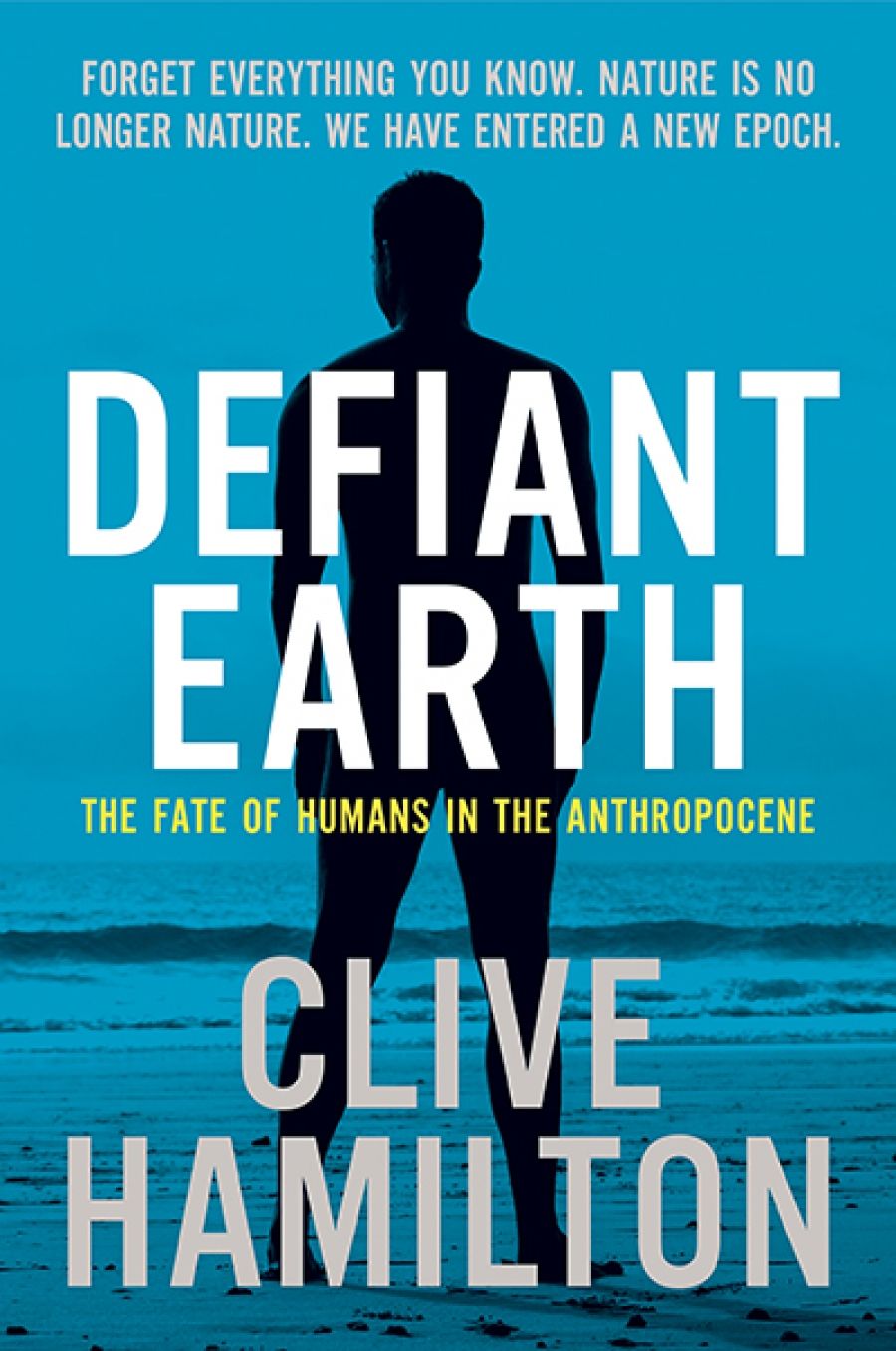
- Free Article: No
- Contents Category: Environmental Studies
- Custom Article Title: Lauren Rickards reviews 'Defiant Earth: The fate of the humans in the Anthropocene' by Clive Hamilton
- Custom Highlight Text:
‘Forget everything you know.’ Clive Hamilton’s book pulls no punches from the first words on the cover. Building on a raft of other pieces he has written on the subject, Hamilton’s book is unsurprisingly provocative, blunt, and confident, its style matching the epic physical, intellectual, and ethical drama that is the ...
- Book 1 Title: Defiant Earth
- Book 1 Subtitle: The fate of the humans in the Anthropocene
- Book 1 Biblio: Allen and Unwin, $29.99 pb, 200 pp, 9781760295967
While the future is unknown and unknowable, it is clear that the new Anthropocene operating state is highly dangerous for species of the Holocene. These species include not just those whose mass demise is part of the change leading to and now accelerating the fall into the Anthropocene, but us, the human species, the ones (blindly) driving the whole thing. As Hamilton puts it: ‘Our best scientists tell us insistently that a calamity is unfolding, that the life-support systems of the Earth are being damaged in ways that threaten our survival.’ ‘Yet,’ he continues, ‘in the face of these facts we carry on as usual.’
Waking up, facing facts, listening to scientists, understanding that the Earth is a single system, and accepting that humans are in the driving seat are core themes in Hamilton’s book. It is a book of Enlightenment in more ways than one. Positioning himself as a kind of humanities equivalent of Paul Crutzen whose frustrated outburst at a scientific meeting is thought to have first put the Anthropocene concept into circulation Hamilton’s frustration and anger at our planetary predicament is palpable. But he also comes with answers, and he wants us to listen to him as well as those of the men of Anthropocene science.
Core to Hamilton’s diagnosis and prescription is a focus on the uniqueness of humankind, namely our limited but singular ‘world-making capacity’. Earth System science, he writes, has ‘exposed both the hidden truth about humans and their environment and opened up new truth about humans and the planet on which worlds are made prompting an ontological shift in self-understanding and the human-Earth relation’. That the Anthropocene demands an ontological rethink is an idea far from Hamilton’s alone. He dismisses numerous other ‘ontological turners’ for their own reinterpretations of the human subject in light of the Anthropocene, particularly those ‘posthumanists’ who question human distinctiveness. Unlike the latter, Hamilton does not call for a more nuanced, ambiguous, or humble understanding of humankind. Rather, he advocates a ‘new anthropocentrism’ that accepts humanity’s role as the ‘Super-agent’ of the planet.
At first glance, such an argument seems to play into the hands of the eco-modernists who have long taken glee in baiting environmentalists with ‘death of nature’ pronouncements and techno-utopian visions of the ‘good Anthropocene’. Hamilton diagnoses their arguments as a self-serving case of Panglossian theodicy (a framework in which the unfortunate harms of the Anthropocene are justified as ultimately ‘for the best’) and derides them for their quietism and hubris. He characterises his own take on human agency as equally open to technology, but far more alert to its moral and physical constraints. For the Anthropocene is not proof of human’s planet-driving skills, he implies, just that we are drivers. It demands that we accept our capacity and duty to more actively manage the Earth, but also to recognise that ‘the Earth has been roused from its peaceful Holocene slumber and is now set on a violent and uncontrollable course’ as a newly defiant and ‘seriously pissed off’ power less willing than ever to follow human instruction.
 'Dawn in the Anthropocene', a photograph by Cuger Brant that shows disposed tyres in a disused chalk quarry in North Kent, England (Wikimedia Commons)
'Dawn in the Anthropocene', a photograph by Cuger Brant that shows disposed tyres in a disused chalk quarry in North Kent, England (Wikimedia Commons)
The Earth is not the only defiant one in Hamilton’s book. The human agent that Hamilton endorses is also one that, while more aware than ever of its mistakes and its deep physical entanglements with nature, embraces its position as a ‘unique and extraordinary power’. Moreover, Hamilton himself is defiant about asserting this bald anthropocentrism and defending the category Human against those who would blur or split it. In adopting this stance, Hamilton does little to allay the concerns of those who see the Anthropocene as the Androcene, not only on account of the disproportionate influence of (wealthy, white) men in creating the actual current catastrophe, but the influence of a similar group in discovering and interpreting the Anthropocene condition for the rest of us. A glance at the endorsing quotes, acknowledgments, and index of the book indicates that Hamilton is clearly a man who likes to debate in ‘bruising encounters’ other men. While that may be natural enough, the masculine orientation of the book combined with his rapid dismissal of the arguments of key female voices on the Anthropocene, such as Donna Haraway, is unfortunate and limiting. If he read such peers more carefully, Hamilton might find not only more sophisticated arguments than he presents them as offering, but also useful tools for thinking through the great question: ‘What do we do now?’
In looking out on the new world of the Anthropocene, Hamilton sees many foes. In this he is not wrong, and his propositions for how to proceed deserve to be taken seriously. But if he stopped and listened a little longer, as he did with Bruno Latour, he may find there are more friends out there than he thinks.


Comments powered by CComment